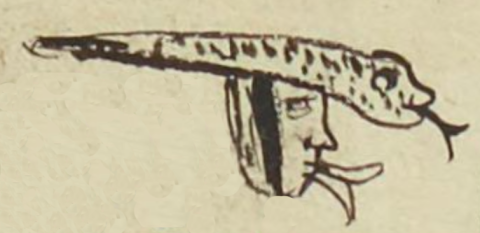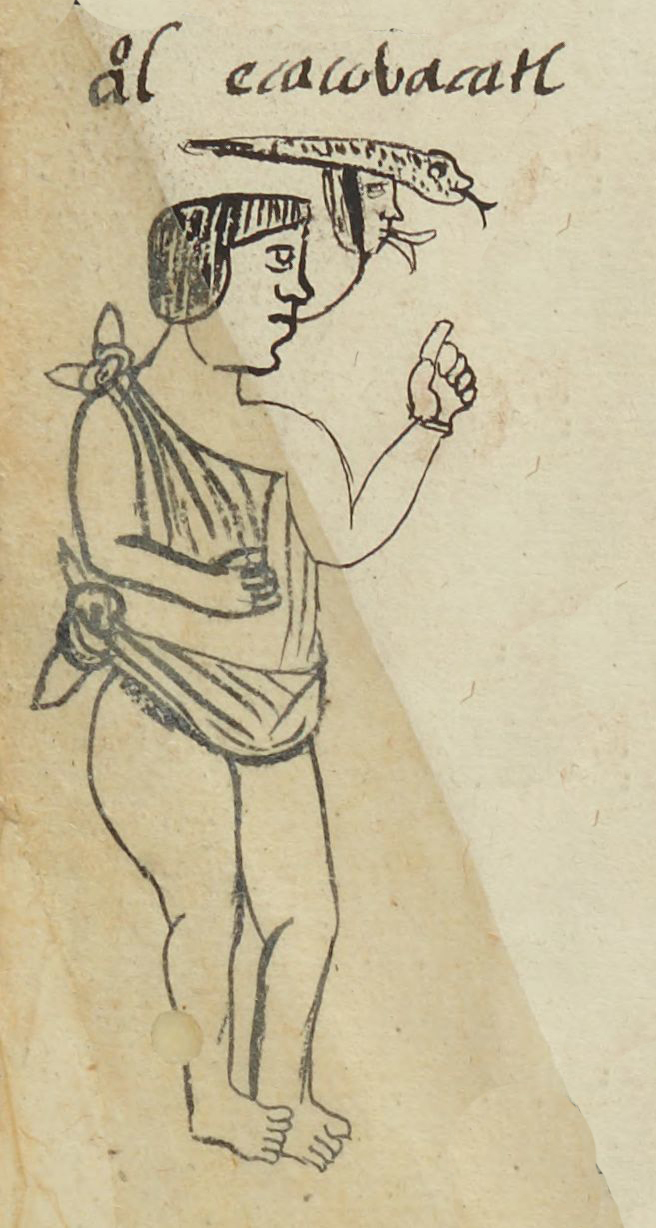Ecacoacatl (MH485v)
This black-line drawing of a compound glyph for the personal name Ecocoacatl consists of, at the top, a horizontal serpent in profile, facing right. It has a protruding, bifurcated tongue and spots all along its body. Below the serpent is an anthropomorphic head in profile, facing to the viewer's right. The face has a thick, vertical, black line (perhaps face paint, perhaps a tattoo) on its cheek, and protruding from its mouth is what appears like an open duck bill or other type of bird's beak.
Stephanie Wood
A great many glyphs in this collection start with Eca- when one might expect Eheca-. We are preserving the proclivity of the gloss for Eca-, while also pointing to the likelihood of an unintentional oral abbreviation of Eheca- to Eca-. The gloss here does not reduplicate the first syllable in Ecatl, a common personal name, but, just as with those names, this is likely a reference to Ehecatl, the divine force of wind and a day sign in the calendar. The serpent adds a significant meaning, of course, and the -catl suffix may refer to an ethnicity, a person from a specific place. This suffix is usually appended to a place name, substituting for -co, as explained in our Online Nahuatl Dictionary.
This contextualizing image shows that this man is drawn in full body, unlike most of the men in the census. Thus, he had an important local role. He is dress in Indigenous-style clothing, but he has a baptismal name, Alonso.
Stephanie Wood
aol ecacovacatl
Alonso Ecacoacatl
Stephanie Wood
1560
Stephanie Wood
wind, viento, serpents, snakes, serpientes, víboras, names, nombres

eca(tl), air/breath, https://nahuatl.wired-humanities.org/content/ecatl
eheca(tl), wind or the divine force associated with it, https://nahuatl.wired-humanities.org/content/ehecatl
coa(tl), snake/serpent, https://nahuatl.wired-humanities.org/content/coatl
-catl (an affiliation suffix, https://nahuatl.wired-humanities.org/content/catl
James Lockhart (The Nahuas, 1992, 120) refers to the name Ecacoatl, witnessed in a census from the Cuernavaca region (1535–45), calling it "Whirlwind."
Matrícula de Huexotzinco, folio 485v, World Digital Library,
https://www.loc.gov/resource/gdcwdl.wdl_15282/?sp=45&st=image.
This manuscript is hosted by the Library of Congress and the World Digital Library; used here with the Creative Commons, “Attribution-NonCommercial-ShareAlike 3.0 License” (CC-BY-NC-SAq 3.0).



